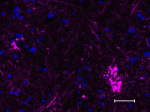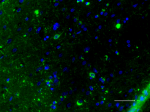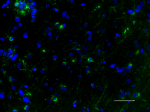- Clone
- M7004D06 (See other available formats)
- Regulatory Status
- RUO
- Other Names
- Microtubule associated protein tau
- Isotype
- Mouse IgG1, κ
- Ave. Rating
- Submit a Review
- Product Citations
- publications

-
IHC staining of HRP anti-Tau Phospho (Thr181) antibody (clone M7004D06) on formalin-fixed paraffin-embedded normal (left panel) and Alzheimer’s disease (right panel) human brain tissues. Following antigen retrieval using Sodium Citrate H.I.E.R. (Cat. No. 928602), the tissues were incubated with 5 µg/mL of the primary antibody overnight at 4°C. DAB was used for detection followed by hematoxylin and bluing solution counterstaining, according to the protocol provided. The images were captured with a 40X objective. Scale bar: 50 µm. -

Western blot of HRP anti-Tau Phospho (Thr181) antibody (clone M7004D06). Lane 1: Molecular weight marker; Lane 2: 20 µg of Alzheimer’s disease human brain lysate; Lane 3: 20 µg of normal human brain lysate. The blot was incubated with 5.0 µg/mL of the primary antibody overnight at 4°C. Enhanced chemiluminescence (Cat. No. 426302) was used as the detection system.
| Cat # | Size | Price | Quantity Check Availability | Save | ||
|---|---|---|---|---|---|---|
Tau protein promotes microtubule assembly and stability. Tau is abundant in neurons of the central nervous system, and is expressed at low levels in astrocytes and oligodendrocytes. Abnormal hyper-phosphorylation, aggregation, and toxic gain of function of tau is associated with several neurological disorders, including Alzheimer’s disease (AD). The major building block of neurofibrillary lesions in AD brains consists of paired helical filaments (PHFs) of abnormally hyperphosphorylated tau. Recent studies indicate that cerebrospinal fluid tau phosphorylated at position threonine 181 has diagnostic utility for several neurological disorders. Six isoforms of tau are generated by alternative splicing of the MAPT gene. These isoforms are distinguished by the number of tubulin binding domains, 3 (3R) or 4 (4R), in the C-terminal of the protein and by one (1N), two (2N), or no (0N) inserts in the N-terminal domain. Tau isoforms are differentially expressed during development.
Product DetailsProduct Details
- Verified Reactivity
- Human
- Antibody Type
- Monoclonal
- Host Species
- Mouse
- Immunogen
- 15-mer pT181 Tau peptide conjugated to KLH.
- Formulation
- This antibody is provided in 50% glycerol in aqueous buffered solutions with preservatives.
- Preparation
- The antibody was purified by affinity chromatography and conjugated with HRP under optimal conditions.
- Concentration
- 0.5 mg/ml
- Storage & Handling
- Upon receipt, the antibody solution should be stored undiluted at -20°C, and protected from prolonged exposure to light.
- Application
-
IHC-P - Quality tested
WB - Verified - Recommended Usage
-
Each lot of this antibody is quality control tested by formalin-fixed paraffin-embedded immunohistochemical staining. For immunohistochemistry, a concentration range of 1.0 - 5.0 µg/ml is suggested. For Western blotting, the suggested use of this reagent is 1.0 - 5.0 µg per ml. It is recommended that the reagent be titrated for optimal performance for each application.
Antigen Details
- Structure
- Unmodified Tau isoforms have an apparent molecular weight ranging from 33-79 kD. Additional high and low molecular weight Tau species have been observed in brain tissues.
- Distribution
-
Tissue distribution: central nervous system, peripheral ganglia and nerves, kidney, skeletal, and heart muscle.
Cellular distribution: cytoskeleton, nucleus, plasma membrane, and cytosol. - Function
- Tau promotes microtubule assembly and stability. The short tau isoforms allow plasticity of the cytoskeleton whereas the longer isoforms may preferentially play a role in its stabilization.
- Interaction
- Tau interacts with Sequestosome-1, Peptidyl-prolyl cis-trans isomerase FKBP4, Casein kinase I isoform delta, Serine/threonine-protein kinase Sgk1, Laforin, Alpha-synuclein
- Molecular Family
- Phospho-Proteins, Tau
- Antigen References
-
1. Meredith JE Jr, et al. 2013. PLoS One 8(10):e76523. PubMed
2. Goodall CA, et al. 2006. J. Neurol. Neurosurg. Psychiatry 77(1):89. PubMed - Gene ID
- 4137 View all products for this Gene ID
- Specificity (DOES NOT SHOW ON TDS):
- Tau Phospho Thr181
- Specificity Alt (DOES NOT SHOW ON TDS):
- Tau Phospho (Thr181)
- App Abbreviation (DOES NOT SHOW ON TDS):
- IHC-P,WB
- UniProt
- View information about Tau Phospho Thr181 on UniProt.org
Related Pages & Pathways
Pages
Related FAQs
Other Formats
View All Tau Phospho (Thr181) Reagents Request Custom Conjugation| Description | Clone | Applications |
|---|---|---|
| Purified anti-Tau Phospho (Thr181) | M7004D06 | IHC-P,Direct ELISA,WB |
| Alexa Fluor® 594 anti-Tau Phospho (Thr181) | M7004D06 | IHC-P,SB |
| Alexa Fluor® 647 anti-Tau Phospho (Thr181) | M7004D06 | IHC-P,SB |
| Alexa Fluor® 488 anti-Tau Phospho (Thr181) | M7004D06 | IHC-P,SB |
Compare Data Across All Formats
This data display is provided for general comparisons between formats.
Your actual data may vary due to variations in samples, target cells, instruments and their settings, staining conditions, and other factors.
If you need assistance with selecting the best format contact our expert technical support team.
-
Purified anti-Tau Phospho (Thr181)

IHC staining of anti-Tau Phospho (Thr181) antibody (clone M7... 
IHC staining of purified anti-Tau phospho (Thr181) antibody ... 
Western blot of anti-Tau Phospho (Thr181) (clone M7004D06), ... 
Direct ELISA of purified anti-Tau Phospho (Thr181) antibody ... -
Alexa Fluor® 594 anti-Tau Phospho (Thr181)

IHC staining of Alexa Fluor® 594 anti-Tau phospho (Thr181) ... -
Alexa Fluor® 647 anti-Tau Phospho (Thr181)

IHC staining of Alexa Fluor® 647 anti-Tau phospho (Thr181) ... -
Alexa Fluor® 488 anti-Tau Phospho (Thr181)

IHC staining of Alexa Fluor® 488 anti-Tau Phospho (Thr181) a... 
IHC staining of Alexa Fluor® 488 anti- anti-Tau Phospho (Thr...
 Login/Register
Login/Register 








Follow Us